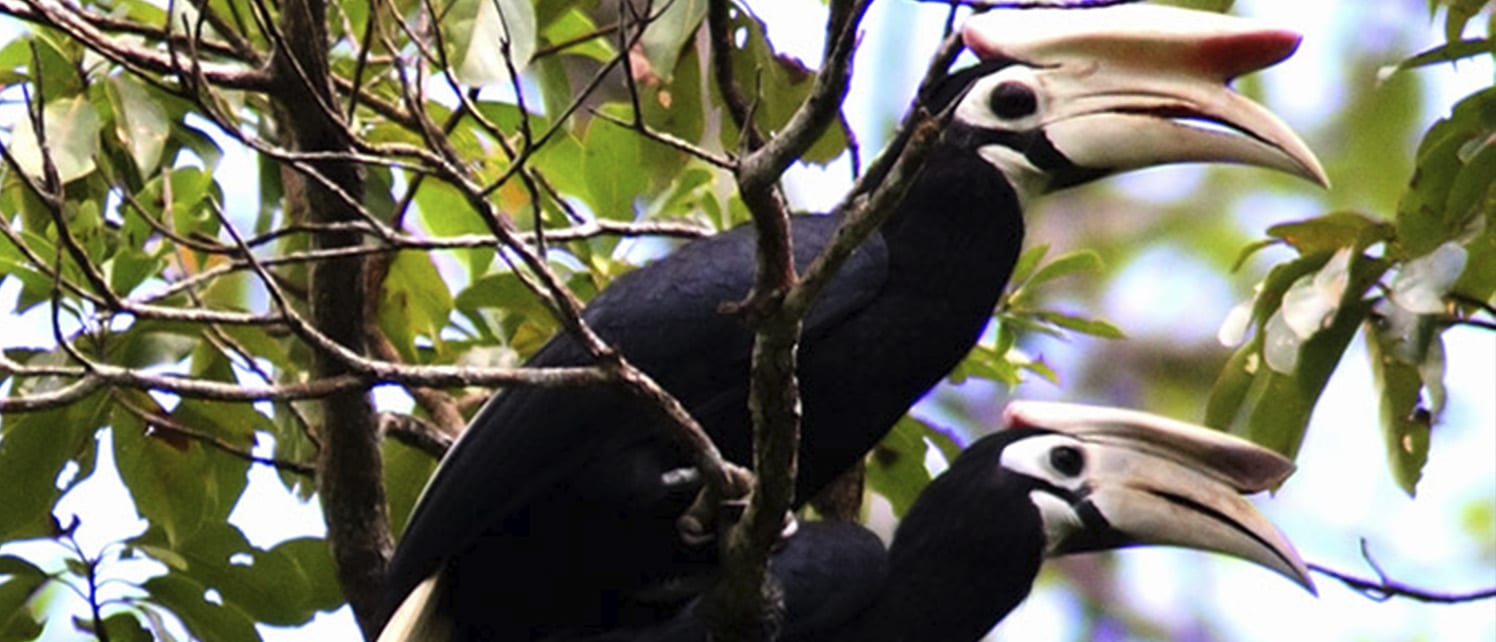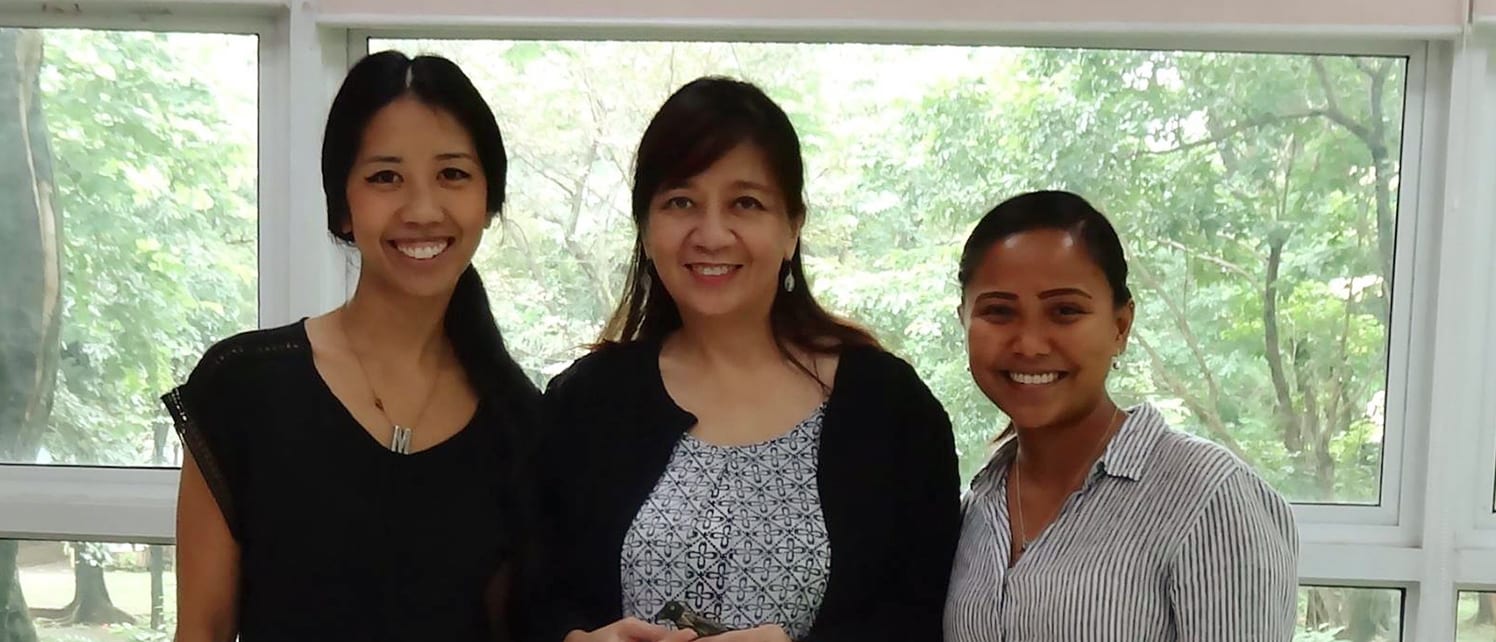Partner Q&A with Centre for Sustainability-Philippines
Rainforest Trust worked with Centre for Sustainability-Philippines (CS-PH) to create Cleopatra’s Needle Critical Habitat in Palawan, which is the largest critical habitat designated in the Philippines. Jessa Belle Garibay (Project Manager) and Karina May Reyes-Antonio (Project Coordinator) share their thoughts on protecting this forested site that harbors some of the country’s most endangered wildlife.
1. What first inspired you to become a conservationist? What brought you to work for Centre for Sustainability-Philippines (CS-PH)?
Jessa: It’s a bit hard to imagine that someone who grew up in what is considered the “Last Frontier of the Philippines” would not automatically want to protect the area and work for conservation. However, I used to be one of the many locals who dreamed of big jobs outside this piece of paradise so that I could earn more, regardless if those jobs gave importance to the environment. I’d like to think what turned me around from these initial aspirations were my positive experiences outdoors, and the many people I’ve met working in conservation, who served as role models for younger generations like my own. The amount of energy local champions dedicated to protecting Palawan’s important areas created a ripple effect in younger people (including myself) to take on the challenges of conserving these areas as well.
Prior to joining CS, I completed one and a half years of training in environmental restoration and trail work in the United States, which inspired me to implement these lessons in my hometown. Now with three years at CS, I can say that more than ever I am very inspired to work on projects that conserve and protect the environment, so I can give back to the land which continues to nurture me and my family! I am also thankful that CS-PH is a good platform to continually learn with a diverse young team of conservationists.
Karina: I started out as a community organizer in South America, working with children and mothers through education and non-violent action in impoverished urban communities affected by narco-trafficking. It wasn’t until I did a life-changing distance university course about environmental security that I realized how disconnected I and the communities in which I was working were to our immediate environment, despite how vulnerable our location was to environmental disasters, especially landslides! Soon after completing that course, my angle for empowering communities drastically changed, and I began pursuing community development projects that actively worked to connect communities with their immediate environment in an effort to overcome their impoverishment. I haven’t looked back since! I was born and raised in Australia to Filipino parents, and after many years working in community development in foreign lands, I returned to the Philippines and landed a volunteer opportunity at CS. CS embodies how I see forward-thinking community development, through projects that include livelihood, education and conservation in a holistic approach. They asked me to stay on as staff soon after joining, and the rest as they say is history!

2. What are some of the key species that are found within the forests surrounding Cleopatra’s Needle?
Jessa: Cleopatra’s Needle Critical Habitat (CNCH) is so large that it is home to countless flora and fauna, many of which are endemic to the area. One of our many favorites is the Palawan Pangolin, which also serves as CNCH’s mascot. The Palawan Pangolin is one of the most highly poached animals in the world! It is one of the eight pangolin species that are all listed in CITES Appendix I, effectively banning them from international trade. Other equally important key species include the rediscovered Palawan Toadlet, the Palawan-endemic pitcher plant Nepenthes mira, the striking Palawan Hornbill and the curious Palawan Bearcat.
Karina: There are so many from which to choose, as CNCH is the largest Critical Habitat across the Philippines with over 100,000 acres! The second, Carmen Critical Habitat for Marine Turtles, stands at one seventh the size at 14,223 acres. Most Critical Habitats are at a smaller range as they focus on only a few species, and that’s what makes this declaration so momentous. The size of CNCH clearly indicates the large number of endemic and/or threatened species that have been identified and recorded, affirming the need for a critical habitat this big!
As CNCH remains largely unstudied, it’s not yet definitive what all of our key species are, but here’s some from our work and research thus far:
• Almaciga tree (Agathis philippinensis). As the tallest tree in Cleopatra’s Needle, I refer to it as our “reigning queen”. It can reach as high as 213 feet tall with diameters of 80-160 centimeters. It’s also the most important species to our Batak community partners, and what’s important to them is important to us! As the primary non-timber product of the forest, its high-value resin (used to produce varnish and paint, among other materials) represents approximately 80 percent of the income for the indigenous people of Cleopatra’s Needle, and their livelihood and cultural traditions revolve around this species. Unfortunately, however, its IUCN Red List Status is Vulnerable, but CS has been working hard since 2014 to remedy this with our exciting propagation project—where we’ve reforested 5,077 seedlings back into Cleopatra’s Needle, and we currently have an additional 11,000 seedlings in our nurseries this season.
• Palawan Bearded Pig. This is another one of those species that is key to the communities, and therefore to us! Unfortunately, its IUCN Status is also Vulnerable. It is an important food source for the indigenous people who have hunted it sustainably for consumption since time immemorial, and as per their continuing rights enshrined in the Indigenous Peoples Rights Act. However, outsiders also increasingly hunt and sell it illegally, which is now driving a tragedy and posing a serious threat to its population.
• Amphibians. All of the 14 amphibian species which make up the amphibian population of Cleopatra’s Needle, especially the six endemic to Palawan, serve to demonstrate the viable and intact forest ecosystem therein. Some of these endemic species include the Palawan Horned Frog and the Palawan Toadlet (Endangered), the Busuanga Wart Fanged Frog and the Philippine Flat-headed Frog (Vulnerable), and the Philippine Toad (Least Concern).

3. Camera traps are helping provide insight into the lives of elusive creatures that might otherwise be inaccessible. What are you learning from the camera traps within CNCH?
Jessa: Knowing that Palawan is relatively understudied compared to other parts of the Philippines, camera trapping activities within Cleopatra’s Needle Critical Habitat provide an excellent opportunity to learn and discover about the area and the species that live in it. It highlights species that are hard to observe because of the remoteness of their habitats or the decline of their numbers in the wild. Through camera traps within CNCH, we are now able to document species which have never been captured on film before, giving us significant baseline data and a powerful tool to reach out to the public about the importance of conserving important areas like CNCH. Raising conservation awareness by sharing camera trapping footage for research gives us a platform to partner up with possible funders, donors, project partners and volunteers to boost our cause!
Karina: We are learning we need more support to do more research! During our 3-month mammals survey, conducted by CS Researcher Paris Marler, we orchestrated a groundbreaking baseline capture of six of the seven known carnivores native to Palawan (including the Palawan Leopard Cat, Asian Small-clawed Otter, Palawan Stink Badger and Short-tailed Mongoose), and other species like our CNCH Mascot – the Palawan Pangolin. Based on the captures, the Palawan Porcupine appears to be the most common carnivore, most commonly found interacting in family groups. We also learned that our carnivores were very curious about pig’s blood, which was our best lure for drawing them in for a photo. Actually, we hope to conduct more camera trapping without bait as this can possibly influence final results. However, during this pioneer study, we were eager to ensure recordings of these animals which were yet to be photographed in their natural habitats, to give us much-needed evidence for the urgency to establish CNCH. But this preliminary camera trapping survey is just the beginning, we need to do more!
4. How has working with the indigenous Batak community helped to strengthen conservation efforts in Palawan?
Jessa: Personally, working with the indigenous Batak community of CNCH gave me a deeper understanding of why these areas truly matter in conservation. Beyond the numerous unique flora and fauna, and beyond the beauty and diversity of forest types found here in this region, I witnessed the deep and meaningful connection between people and nature. This connection, lost by many among us, is kept alive by groups like our Batak partners who have lived harmoniously with their environment since time immemorial. Working with the indigenous Batak community helped justify the need to protect the forests, as many people depend on it for shelter and livelihood. The people’s deep knowledge of the forests of CNCH provided a thorough foundation for baseline data, finding our way in the forests, identifying species and their existence and a whole lot more information that strongly supported the success of the declaration of CNCH.
Karina: The work we’ve done thus far in collaboration with our Batak community partners has provided the critical foundation for establishing the CNCH. As we all know though, the declaration is just the tip of the iceberg. So, by already having this strong and productive working relationship, our real conservation work will be even more effective moving forward as we lift the conservation status of CNCH off the page and work together to make it a real, functioning protected area in practice. Ultimately, conserving our rich natural environment here in Palawan starts and finishes with our local communities, especially our Batak community partners. As the only inhabitants of this forest, they are its true guardians who have the good fortune of living, breathing and interacting with and in it every day.

5. What advice would you give to other women looking to become involved in conservation?
Jessa: Based on my personal experience growing up as a female in the Philippines, which deems true for many females I know who were born and raised here, working outdoors and being in conservation would probably be the last thing people would expect of you. However, it should not stop you from pursuing your dreams, especially in exploring the outdoors! I know first-hand that you should find a good support system who believes that you can do just about anything, and break all the stereotypes that try to pigeonhole us. In my case, I had role models and family members who were supportive of things that matter to me. Find those people—and build upon what they think are your strengths, and learn from criticism. Finally, just remember that we all have and/or can gain skills just as much as men can, and that what it all boils down to is the amount of passion you have within you and how much you are willing to learn regardless of your gender and preferences!
Karina: Do it, we need you! Concretely, create yourself a network of support, especially with other local female conservationists who can really relate to the immediate challenges you might be facing and help you find day-to-day solutions. Keep your smile on always and your wits about you, get fierce and feisty when needed, but always remain professional so it’s clear that they’re never going to get you down, and that they’re definitely not going to get in your way. In my experience, the world has a habit of giving way to those of us on a mission—eventually! Finally, always trust your gut instinct and let that guide you—if you don’t trust yourself, then who will?




